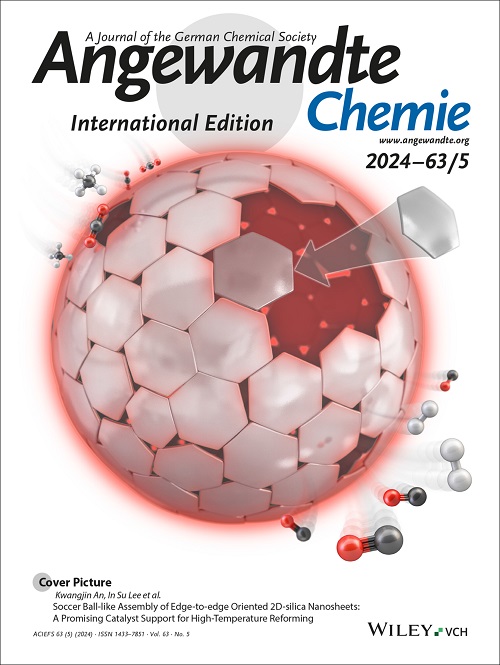Harnessing Pyridinic N Vacancy Defect in Microporous Structures to Induce the Pre-Adsorption of Oxygen and Boost Oxygen Reduction Reaction Kinetics.
IF 16.9
1区 化学
Q1 CHEMISTRY, MULTIDISCIPLINARY
引用次数: 0
Abstract
Defect structures within the carbon matrix play a crucial role in enhancing the oxygen reduction reaction (ORR) activity of Fe single atom and nitrogen-doped catalysts (Fe-N-C SACs). However, overlooking the O2 pre-adsorption process induced by defective structures hampers the precise identification of active sites and the investigation of the reaction mechanism in Fe-N-C SACs. Hence, we report a Fe SAC with abundant pyridinic N vacancy defects in microporous structures (Fe-Nv-C SAC) and propose a synergistic effect between pyridinic N vacancy defects and O2 molecules that promotes the kinetics of ORR. The developed Fe-Nv-C SAC demonstrates exceptional ORR performance, exhibiting superior mass activity and turnover frequency compared to conventional Fe-N-C SACs. The in situ Fourier transform infrared spectroscopy (FTIR) and theoretical calculations indicate that pyridinic N vacancy defects in microporous structures facilitate pre-adsorption of O2 molecules results in the d-band centers of central Fe atoms shifting away from the fermi level. This shift weakens the adsorption strength of *OH species, thereby facilitating the kinetic process of ORR. This work addresses a critical gap in the field of electrocatalysis by providing the experimental validation of pre-adsorption of O2 molecules on Fe single-atom catalysts, a phenomenon previously only speculated through theoretical calculations.利用微孔结构中吡啶N空位缺陷诱导氧的预吸附并提高氧还原反应动力学。
碳基体内的缺陷结构对铁单原子和氮掺杂催化剂(Fe- n- c SACs)氧还原反应活性的提高起着至关重要的作用。然而,忽略了由结构缺陷引起的O2预吸附过程,阻碍了Fe-N-C SACs中活性位点的精确识别和反应机理的研究。因此,我们报道了一种在微孔结构中含有丰富吡啶N空位缺陷的Fe- nv - c SAC (Fe- nv - c SAC),并提出了吡啶N空位缺陷与O2分子之间的协同作用,促进了ORR的动力学。与传统的Fe-N-C SAC相比,所开发的Fe-N-C SAC具有出色的ORR性能,具有更好的质量活性和周转频率。原位傅里叶变换红外光谱(FTIR)和理论计算表明,微孔结构中的吡啶N空位缺陷有利于O2分子的预吸附,导致中心铁原子的d带中心偏离费米能级。这种转变削弱了*OH的吸附强度,从而促进了ORR的动力学过程。这项工作通过提供O2分子在Fe单原子催化剂上预吸附的实验验证,解决了电催化领域的一个关键空白,这种现象以前只能通过理论计算推测。
本文章由计算机程序翻译,如有差异,请以英文原文为准。
求助全文
约1分钟内获得全文
求助全文
来源期刊
CiteScore
26.60
自引率
6.60%
发文量
3549
审稿时长
1.5 months
期刊介绍:
Angewandte Chemie, a journal of the German Chemical Society (GDCh), maintains a leading position among scholarly journals in general chemistry with an impressive Impact Factor of 16.6 (2022 Journal Citation Reports, Clarivate, 2023). Published weekly in a reader-friendly format, it features new articles almost every day. Established in 1887, Angewandte Chemie is a prominent chemistry journal, offering a dynamic blend of Review-type articles, Highlights, Communications, and Research Articles on a weekly basis, making it unique in the field.

 求助内容:
求助内容: 应助结果提醒方式:
应助结果提醒方式:


